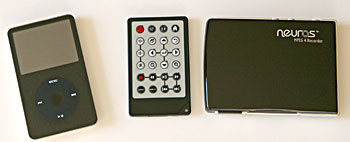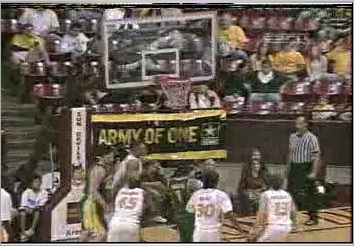|
|
|||||||
|
Apple iPod, PSP and PDA Accessory Reviews Neuros RecorderEditor's rating (1-5): Reviewed Feb., 2006 by Jacob Spindel Editor's note, May 2008: Check out our review of the latest model, the Neuros OSD. Quantum Leap Podcasts. You know you love them. It's just fun to have fresh content on your media player on a daily basis, instead of only listening to your favorite songs over and over. The only problem is... they're not really that good. Although some podcasts are truly awesome, many are boring, and many are just never updated. If only you could get the flexibility of podcasts with the content of, say... television. Sure, there's the iTunes Music and Video Store, which is pretty cool, but the videos can only be played in iTunes or on an iPod video—and perhaps even worse, the selection just hasn't reached "critical mass" yet. If your tastes are a little less "SpongeBobCast" and a little more oriented towards shows that aren't yet on iTunes—Friends, My Name Is Earl, The Simpsons, and Seinfeld, to name a few—then iTunes can't help you. Moreover, even if iTunes started carrying lots more shows, any program that airs daily would theoretically cost you $10/week to download, which is not exactly appealing. Enter Neuros Technology, with what purports to be the missing link in your digital convergence: the Neuros Recorder. Available in two models, the Recorder 1 and 2 both aim to enable you to take television across that elusive "leap" right into your pocket. The Recorder 2 can produce higher quality recordings and is targeted at the iPod 5G and PSP, but since it has neither an SD card slot nor a USB port, it isn't a great match for PDA users. Thus, today, I take a look at the Neuros Recorder 1. NUMB3RS At 4.6 x 3.42 x .71 inches and 4.9 ounces, the recorder looks way too small to be a tiny VCR, but it is one—sort of.
iPod Video 30 gig, the Neuros Remote and the Neuros Recorder The Neuros Recorder 1 has two slots on its front, one for SD cards, and one for CompactFlash cards. You can record television shows on either card type, though the Recorder itself has no built-in storage. On the back, you'll find input and output adaptors, both of which use the composite (RCA) cabling, as well as a USB connector and the port for the power cable. (The cables are stereo, but the Recorder can only record in mono.) Except for one small green light, the Recorder has no buttons, controls, displays, or indicators on it—everything else is on the included remote. The Recorder creates files that use an ASF video codec (MPEG4-based), and the G.726 audio codec, with four quality settings available (The Recorder 2 records in MPEG4 with AAC audio). Depending on which setting you use, a 512 MB SD card can hold anywhere from 45 minutes to 177 minutes. This is admittedly not a lot. However, I found that the video quality was more than acceptable (though still noticeably degraded from the original) on all but the lowest quality setting, and you really only need to be able to store enough video for however long you'll be out of the house—then you can just pop the SD card into a card reader, transfer the file to your computer, and burn it to a CD or DVD if you want to save it. Don't have a card reader? No problem, just flip the switch on the back of the Recorder and connect it to your computer, and you instantly have a USB 2.0 High Speed card reader. |
Advertisement |
|
Side view with AV jacks
Obviously, higher-capacity storage cards are a good idea for use with the Recorder, but don't forget that, no matter how large a card is, it can't be in two places at once. If you intend to watch movies on your PDA while simultaneously recording something at home, you may need to buy an additional card, even if you already use SD "for everything." The files it creates are compatible with TCPMP, using just the codecs that are publicly available from the official site. They also play on the recently discontinued Windows Media Player on my Mac; however, I had many problems getting them to work with Flip4Mac-WMV, Microsoft's recommended third-party replacement. This plugin definitely needs major improvements—it is not an issue specific to the Recorder. Neuros says that Recorder 1 files won't play on a PSP without conversion, but they do include a piece of software called "Video Toolbox" for editing the videos, which they say is a "$49.95 retail value." Perhaps they should've added that, "for Mac users, it is a $0 value." However, you don't actually need any computer or software to use the Recorder, and in a pinch, you can just take an SD card straight from the Recorder to a PDA and watch the newly recorded video. And if your primary goal is PSP or iPod playback, get the Recorder 2. The two units are identical except the Recorder 1 has CF and SD slots and records in ASF while the Recorder 2 has CF and MemoryStick slots and records in MPEG4 with AAC audio. Unfortunately, the Recorder does not have a tuner of any kind, so you'll have to connect it to an existing VCR or other device, if you want to record live TV. You also can't change the channel using any setting on the Recorder, so you may have to program your VCR to record at the same times as your Recorder, leading me to the unfortunate conclusion that, in order to use the Recorder as a VCR, you need... a VCR. Or plug it into your TV's AV out jacks (if present) and be prepared to watch the very same thing you're recording. The good news is that the Recoder has a clever "Auto Record" mode, which will cause it to start recording, without any additional programming, whenever it receives a signal from a VCR (or whatever it's connected to), so using it as a companion to a VCR is actually a workable option, and not really much of a hassle at all. However, not only is "Auto Record" not explained in the manual, but it also tends to switch on and off repeatedly when it receives a poor signal. Since I observed this even with moderate-quality signals that never "dropped out" entirely when viewed with a regular TV, I believe this may be a bug in the Recorder. The device uses a graphical on-screen interface, which you can navigate with the included remote. The interface is hit-and-miss; the four clearly labeled "applications" are simple to understand, including a photo viewer, MP3 player, video player, and video recorder. However, it's hard to keep track of which menus are in which program, or which button accesses which feature, especially since the buttons on the remote are arranged in two ordinary columns, rather than arranging the arrow keys and other buttons in a more intuitive manner. This may have been a size consideration, but it definitely takes some getting used to. The MP3 player, photo viewer, and video player are all practically self-explanatory. The navigation of the folders on the inserted card(s) is straightforward, and it is simple to view (or listen to) your media items, albeit at the limited quality level a TV or VCR can provide. The video recorder is where all the "action" is at. Here you can enable Auto Record, create a preset recording program, or adjust the quality settings of the output video recordings. Unfortunately, the recording application's interface also makes it too easy to "shoot yourself in the foot." For example, it will not warn you if you set a recording timer but the clock has not been set. Also, if you exit the recording "application," Auto Record will not work. Finally, after the Recorder finishes recording, your TV screen (if connected to the Recorder's output) cryptically blinks the word "Space:" over the screen for anywhere from a couple of seconds to several minutes, which may cause you to think that the device has crashed. If you remove the card or unplug the Recorder during this time, the card will not contain any usable data. However, I soon realized that the device is apparently still processing when it is in this state, and if you leave it alone, it will eventually wake up and complete a usable file. Although the Recorder can be used in combination with a Tivo, satellite service, or similar device, it is not meant to replace a full-fledged PVR. It doesn't have any built-in programming guides or other PVR-level bells and whistles, but this also means that the one thing everyone has been hoping for has come true: you don't have to subscribe to ANYTHING. (Cue the choir singing "Hallelujah.") The View Once I got past a few mishaps because of the interface quirks noted above, I was able to start recording all the shows I normally tape in digital format, in addition to plain old VHS. Yes, at long last, I could finally fulfill my dream of watching The People's Court on the bus. But is it even worth it?
Sample TV recording
Overall, I am impressed with the video quality. Still images look about as clear and sharp as they do on my (non-HD) TV, even though the resolution is lower, and when I watched the video on TCPMP, the animation was reasonably fluid with a good frame rate (Neuros claims it can reach 25 fps on the highest setting), even on my modest iPaq 1940. I realized that watching TV on the go has some drawbacks I didn't think of, such as the fact that many TV shows are longer than most people have available when they're waiting for something or someone, and that most transflective LCD screens weren't really designed for outdoor use. These are, of course, not specific to the Neuros Recorder. Overall, I think the Neuros is one of the easiest and least expensive ways to transfer television to a PDA. In fact, you can even transfer commercial DVDs this way. The Recorder does not appear to be affected by the copy-protection "feature" that can cause the video to lose its vertical hold and jump up and down when a DVD is copied to a VHS tape.
Sample DVD recording
Although the lack of a tuner is primarily a disadvantage, it does theoretically open up the possibility that a digital tuner could be connected to the Recorder in the future. Obviously, this will not improve the resolution or data rate of the output, but since the Feds are threatening to pull the plug on analog TV as early as 2009, this may be something to consider. I was also a bit frustrated by the fact that the resolution of the Recorder 1's videos, though supposedly targeted at PDAs, is actually 352x240 rather than 320x240 (which is what most PocketPCs' screens use). If you play a 352x240 video in TCPMP, it is forced to scale the video down to compensate for the extra width, which means that the viewable movie area on a PocketPC is even less than 320x240. The only other resolution option is 176x144, which saves a lot of space, but obviously videos at this resolution don't look very good. The Recorder 2's resolutions fit their target perfectly at 320 x 240 for the iPod, 368 x 208 for the Sony PSP and VGA for TV playback. |
Advertisement |
|
The Weakest Link The biggest problem with the Neuros Recorder 1 is the audio quality. Although you can improve it somewhat by not using Economy mode, by not using Flip4Mac (for now at least), and by not using the built-in speaker of a PocketPC, no matter what you do, the G.726 codec was intended primarily for voice recordings, and you may notice some scratchiness or static, even from "immaculate" sources like a local video tape of a purchased movie. If you are careful about the above issues, you can probably minimize the static to an acceptable level, but it is still mildly annoying, even on higher quality settings. I would not recommend this device for someone whose primary goal is music-related. Deal... or No Deal? If you've been as eager as I have to incorporate your television into your "digital lifestyle," the Neuros Recorder is a good choice, especially for PDA users. Although the quality level and programming options are not near the level of a full-fledged PVR/DVR, it gets the job done in a way that is effective and convenient enough to satisfy your TV-to-digital cravings. Taking into account the overall video quality and usability of the device, I think it is a very good value at $99, even if it may not be able to compete quite as well with more expensive devices. Pros: Convenient, small, and inexpensive; works with DVDs; compatible with TCPMP; Auto Record feature is (mostly) clever and powerful. Price: $99 Web Site: www.neurostechnology.com
|




